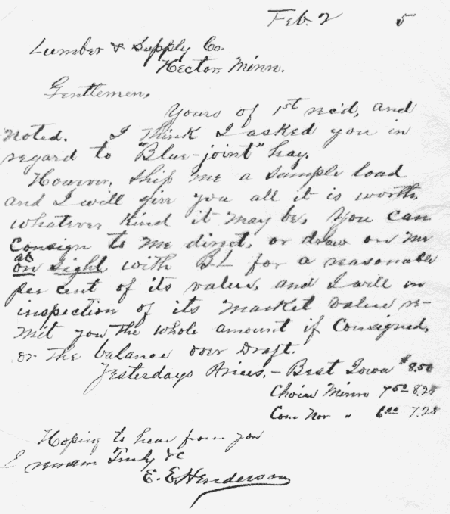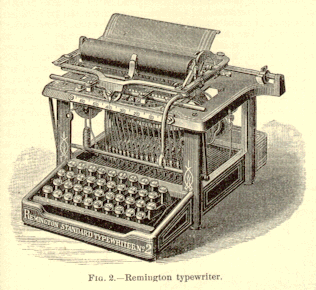Typewriter
Today, let's look at typewriters. The University of Houston's College of Engineering presents this series about the machines that make our civilization run, and the people whose ingenuity created them.
I have an odd artifact here. It's my great-grandfather's letter book -- a bound volume with only tissue-paper pages remaining. He once wrote letters, with a dipped inkpen, on regular paper between the tissues. Before he tore the letters out and mailed them, he blotted them on the tissue, leaving copies behind. Here's the fuzzy imprint of a letter written in 1891:
Gentlemen, Please quote me the expense of shipping 1 car load of saw dust from your station.
Why did he use such a crude method? Well, carbon paper had been around for 22 years, but you couldn't press hard enough on a dipped pen to use it. With a typewriter and carbon paper, copying would've been a cinch; and the typewriter was also around by then.
A man named Christopher Sholes had started developing it in 1867. He drew in coinventors, and together they made improvements. In 1872 they found a manufacturer in the small-arms maker Remington. With the Civil War ended, Remington needed a peacetime product. The first Remington machine came out in 1874, and by 1878 it had developed into something very much like the modern manual typewriter. So why was great-grandpa still using inkpens and blotter-copies in 1891?
Historian Cynthia Monaco tells us that only 5000 typewriters had been sold by 1880. People loved to watch demonstrations of the machines in stores. It was an exciting novelty but not something they saw any use for in their daily lives.
After all, letter-writing was a Victorian rite -- something done according to rules and conventions. Good hand-written letters were the mark of a lady or a gentleman. A typed letter looked like a printed flyer. Even a backwoodsman was offended when he got his first typewritten letter. He replied, "You don't need to print no letters fer me. I kin read writin'."
Remington did badly at first because he tried to sell these machines to domestic buyers. When he finally triumphed it was because the business world saw the value of the machine. Ten times as many typewriters were sold between 1880 and 1886 as were sold in the preceding six years. When my grandpa wrote his letter to the lumber company in 1891, he was already behind the times. By then, most small businesses had at least one typewriter.
Like so many other machines -- like today's word processors -- the typewriter had to teach us what it could do after it was invented. After all, we still like to receive a handwritten note from a friend; but how long could we survive in today's business world using handwritten letters and blotter copy-books?
I'm John Lienhard, at the University of Houston, where we're interested in the way inventive minds work.
(Theme music)
Monaco, C., The Difficult Birth of the Typewriter. American Heritage of Invention and Technology, Spring/Summer 1988, pp. 10-21.
This episode has been greatly revised as Episode 1532.

A leaf from Great-grandpa's copy book, 1891

(From Appleton's Cyclopaedia of Applied Mechanics, 1892)
An early Remington typewriter